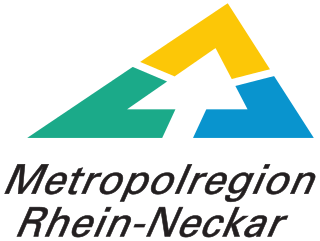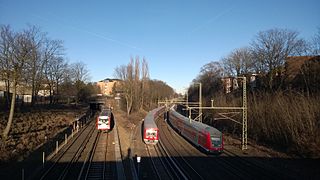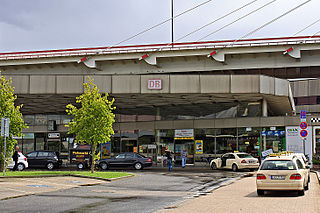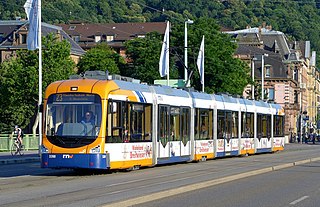
Baden-Württemberg, commonly shortened to BW or BaWü, is a German state in Southwest Germany, east of the Rhine, which forms the southern part of Germany's western border with France. With more than 11.07 million inhabitants as of 2019 across a total area of nearly 35,752 km2 (13,804 sq mi), it is the third-largest German state by both area and population. As a federated state, Baden-Württemberg is a partly-sovereign parliamentary republic. The largest city in Baden-Württemberg is the state capital of Stuttgart, followed by Mannheim and Karlsruhe. Other major cities are Freiburg im Breisgau, Heidelberg, Heilbronn, Pforzheim, Reutlingen, Tübingen, and Ulm.

Mannheim, officially the University City of Mannheim, is the second-largest city in the German state of Baden-Württemberg after the state capital of Stuttgart, and Germany's 21st-largest city, with a 2020 population of 309,119 inhabitants. The city is the cultural and economic centre of the Rhine-Neckar Metropolitan Region, Germany's seventh-largest metropolitan region with nearly 2.4 million inhabitants and over 900,000 employees.

Ludwigshafen, officially Ludwigshafen am Rhein, is a city in the German state of Rhineland-Palatinate, on the river Rhine, opposite Mannheim. With Mannheim, Heidelberg, and the surrounding region, it forms the Rhine Neckar Area.

The Rhine-Neckar Metropolitan Region, often referred to as Rhein-Neckar-Triangle, is a polycentric metropolitan region located in south western Germany, between the Frankfurt/Rhine-Main region to the North and the Stuttgart Region to the South-East.

Eppelheim is a city in northern Baden-Württemberg bordering Heidelberg. It belongs to the district Rhein-Neckar-Kreis.

Mannheim Hauptbahnhof is a railway station in Mannheim in the German state of Baden-Württemberg. It is the second largest traffic hub in southwestern Germany after Stuttgart Hauptbahnhof, with 658 trains a day, including 238 long-distance trains. It is also a key station in the Rhine-Neckar S-Bahn. 100,000 passengers embark, disembark or transfer between trains at the station each day. The station was modernised in 2001. It is classified by Deutsche Bahn as a category 2 station.

The Rhine-Neckar S-Bahn(S-Bahn RheinNeckar) forms the backbone of the urban rail transport network of the Rhine Neckar Area, including the cities of Mannheim, Heidelberg and Ludwigshafen.

The Karlsruhe Stadtbahn is a German tram-train system combining tram lines in the city of Karlsruhe with railway lines in the surrounding countryside, serving the entire region of the middle upper Rhine valley and creating connections to neighbouring regions. The Stadtbahn combines an efficient urban railway in the city with an S-Bahn, overcoming the boundary between trams and trains. Its logo does not include the green and white S-Bahn symbol used in other German suburban rail systems and the symbol is only used at stops and stations outside the inner-city tram-operation area.

Rapid transit in Germany consists of four U-Bahn systems and fourteen S-Bahn systems. The U-Bahn commonly understood to stand for Untergrundbahn are conventional rapid transit systems that run mostly underground, while the S-Bahn or Stadtschnellbahn are commuter rail services, that may run underground in the city center and have metro-like characteristics in Munich, Hamburg and Berlin which they only have to a lesser extent in other cities. There are also over a dozen premetro or Stadtbahn systems that are rapid transit in the city center and light rail outside.

The Mannheim–Saarbrücken railway is a railway in the German states of Baden-Württemberg, Rhineland-Palatinate and the Saarland that runs through Ludwigshafen am Rhein, Neustadt an der Weinstraße, Kaiserslautern, Homburg and St. Ingbert. It is the most important railway line that runs through the Palatinate. It serves both passenger and freight transport and carries international traffic.

The Verkehrsverbund Rhein-Neckar (VRN) is a transport association covering parts of the German states of Baden-Württemberg, Rhineland-Palatinate and Hesse in south-west Germany. Founded in 1989, it initially served the Rhein Neckar Area, but has since grown beyond its borders to cover an oblong area of 10,000 km2 with a population of 3 million, including Mannheim and Ludwigshafen, Heidelberg, Kaiserslautern, the entire Palatinate Forest and the northernmost parts of Baden-Württemberg. VRN tickets can also be used for journeys to and from several neighbouring areas, including the French town of Wissembourg.

The Mainz–Worms–Ludwigshafen Railway connects Mainz via Worms to Ludwigshafen in the German state of Rhineland-Palatinate. From there trains cross the Rhine via Mannheim or run south towards Speyer. It was opened in 1853 and is one of the oldest railways in Germany.

Ludwigshafen (Rhein) Hauptbahnhof is a railway station at Ludwigshafen am Rhein in the German state of Rhineland-Palatinate. A combination of a wedge-shaped station and a two-level interchange, the station is at the junction on the lines from Mainz and Neustadt an der Weinstrasse to Mannheim. It is classified by Deutsche Bahn as a category 2 station. The Ludwigshafen station was built in 1847 as a terminal station in the centre of modern Ludwigshafen. The current station was built in 1969 to the west of the city centre, but has not proved to be a success due to its poor location.
The Upper Rhine Railway Company, was a railway infrastructure company and transport company based in Mannheim, Germany. It operated the metre-gauge railways among Mannheim, Heidelberg and Weinheim. The company was merged with MVV Verkehr AG on 16 March 2010.

The Heidelberg tramway network is a network of tramways forming an important element of the public transport system in Heidelberg, a city in the federal state of Baden-Württemberg, Germany. Opened in 1885, the network has been operated since 2009 by Rhein-Neckar-Verkehr (RNV) within the Verkehrsverbund Rhein-Neckar (VRN). The network includes line 5 of the Mannheim/Ludwigshafen tram system, which is connected with Heidelberg’s tram system via the Upper Rhine Railway Company.

The Mannheim/Ludwigshafen tramway network is a metre-gauge transport network of tramways focused on the cities of Mannheim and Ludwigshafen am Rhein, and connected to Heidelberg and Weinheim via the Upper Rhine Railway Company (OEG), in the Rhine Neckar Area of Germany.

The Mannheim–Weinheim railway is a metre-gauge railway between Mannheim-Neckarstadt-Ost/Wohlgelegen and Weinheim, mainly in the German state of Baden-Württemberg. It was built by the former Oberrheinischen Eisenbahn-Gesellschaft AG, later MVV OEG AG and is now operated by MVV Verkehr GmbH and RNV according to Eisenbahn-Bau- und Betriebsordnung für Schmalspurbahnen. However, the line is still owned by MVV Verkehr AG as the successor to the OEG. It is operated as a branch line using electronic direct traffic control.

The Weinheim–Heidelberg railway is a metre-gauge railway between Weinheim and Heidelberg in the German state of Baden-Württemberg. It was built by the former Oberrheinischen Eisenbahn-Gesellschaft AG, later MVV OEG AG and is now operated by MVV Verkehr GmbH and RNV according to Eisenbahn-Bau- und Betriebsordnung für Schmalspurbahnen. A short dual gauge section between Heidelberg and Schriesheim was formerly operated to carry standard gauge freight. It is operated as a branch line using electronic direct traffic control.

The Mannheim Kurpfalzbrücke–Heidelberg railway is a metre-gauge railway between central Mannheim and Heidelberg-Bergheim. It was built by the former Oberrheinischen Eisenbahn-Gesellschaft AG, later MVV OEG AG and is now operated by MVV Verkehr GmbH and RNV according to Eisenbahn-Bau- und Betriebsordnung für Schmalspurbahnen. The route connects the Mannheim tram network with the Heidelberg tram network. However, the line is still owned by MVV Verkehr AG as the successor to the OEG. It is operated as a branch line using electronic direct traffic control.

The Mannheim-Käfertal–Heddesheim railway is a metre-gauge railway between Mannheim-Käfertal and Heddesheim, in the German state of Baden-Württemberg. It was built by the former Oberrheinischen Eisenbahn-Gesellschaft AG, later MVV OEG AG and is now operated by MVV Verkehr GmbH and RNV according to Eisenbahn-Bau- und Betriebsordnung für Schmalspurbahnen. However, the 6.5 km-long line is still owned by MVV Verkehr AG as the successor to the OEG. It is operated as a branch line using electronic direct traffic control.
















